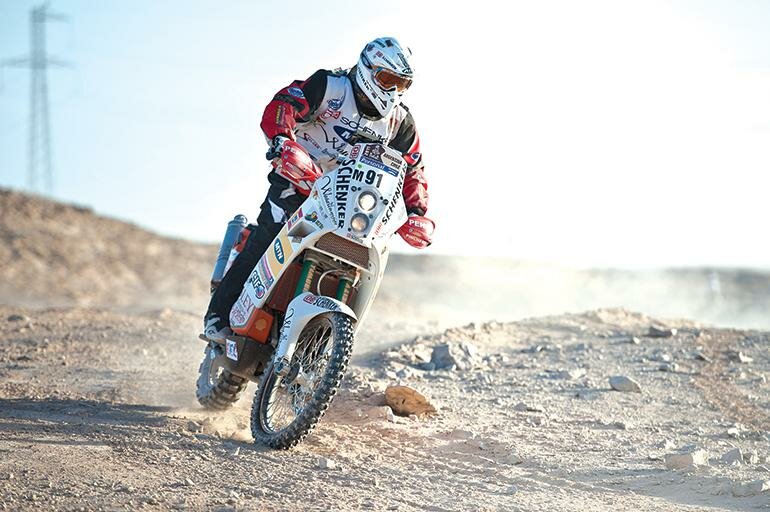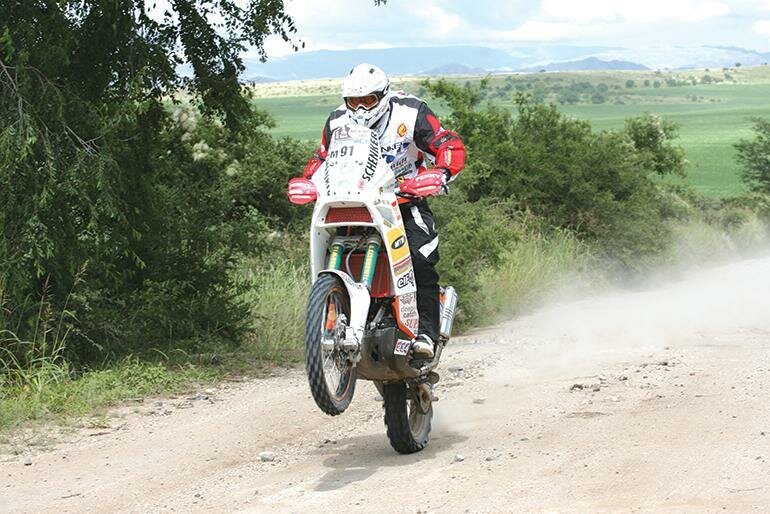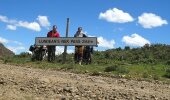Words by Ingo Waldschmidt, two-time Dakar competitor | Photos courtesy of Ingo Waldschmidt
After spending many, many months of training and preparation, Darryl Curtis entered his first Dakar Rally this year from 1-15 January. As I have competed twice at this famous off-road rally in the past, my experiences will give you an inkling of what he faced, as he rode through Argentina, Chile and Peru to cover a distance of more than 9 000km.

There are many different aspects to competing at the Dakar, the most significant being the tremendous amount of time spent preparing for the race and coming up with almost a million Rand, to see you through to the finishing line. Although the actual Dakar Rally is ‘only’ a two-week long event, it takes a good year to get organised, prepped and in shape to compete.
For most, the Dakar becomes a reality when they are financially stable, in their late thirties, early forties and mentally and physically ready, as before that it just remains a dream.
Those fortunate to take part are either able to afford to pay most of the hefty expenses out of their own pocket, or they’ve built a reputation in motorsport and are lucky enough to find sufficient sponsors to cover the costs. Darryl was one of those lucky ones! His 20 years of experience competing locally and in some of the most difficult races around the world has earned him an enviable reputation, and sponsorship was secured with Broadlink.
Once the financial obligations have been taken care of, a good, reliable bike is needed, as well as backup for services and parts, a great mechanic and a reliable team to provide support and motivation. KTM SA came to the party here for Darryl by sponsoring a race-ready 450 Rally Factory Rep – a beast of a bike!
The Dakar is by far the toughest rally in the world and when covering such a huge distance, navigation skills are key to finishing the event. What this means is that the fastest rider may not necessarily win, but rather the smartest rider, who is able to navigate well, pace himself over the total distance, stay upright, have the least mechanical hiccups and the stamina and fitness to race the distance. To finish is an accomplishment in itself and something to be exceptionally proud of.
Days before the start of the actual race, Darryl, along with every other competitor, would have had to pass a lot of tests and checks to be able to compete. This is a nerve-racking experience because if just one little thing is not working or not in place, their race is over before it even starts. But once through, they’ll be in the limelight, surrounded by the world’s best riders, cheering fans and camera crews from all over the world vying for interviews; it will all prove pretty mind blowing and surreal.
For anyone competing that is not a fully sponsored rider and racing in the top 20, they will need to keep reminding themselves to take it easy and rather ride at a slower pace, to avoid a big and costly crash. To finish is their aim, no matter what. Once they’ve managed to get through a couple of days of ‘safe’ riding and become more confident navigating, then they can open the taps and really start to enjoy the ride.
The biggest problem any competitor faces at the Dakar is the lack of sleep, and fatigue catches up with you real fast in these hot, challenging conditions. The bivouacs are extremely noisy at night and this often results in a rider only managing to get about four to five hours sleep. Being physically and mentally fit to cope with sleep deprivation is key, as a lapse in concentration could result in a mistake, such as an injury, or in the worst case an exclusion, which could cost a rider precious time.

At the halfway point, riders will enjoy a much-needed rest day. This is when they get a chance to wash sweaty and dust-stained riding gear (by themselves I might add), check their bike thoroughly, change over to a new engine and recap on the next week to come. However, every rider treats this day differently, but if one looks again the day will have flown past and they probably won’t have had any rest at all.
The organisers of the Dakar, in general, treat the first five days as the easier days. Thereafter they step up their game by making the special stages much tougher and longer, and a lot of the riders start to fall out from this point onwards. For most, the last couple of days will be more like a survival run, where only the best riders make it to the finish.
Looking on the bright side though, the bivouacs become less crowded, the queues at the eating tent and ablutions shorter, and they will get to shower for longer. But even with these small luxuries, riders will still be counting the hours to that last day and the finish line. The camaraderie amongst the competitors is amazing, and the closer you get to the finish, the more you help each other out.
To finish this race is truly sweet. Tears of happiness and pure joy flow, as you are just so thankful to have made it in one piece and be reunited with loved ones at the finish line. It’s very, very special.
During the event bonds are formed with people like your mechanic and the rest of your team members, and friendships are made that will last a life time. To ride up onto the podium, with your country’s flag flying proudly, and hold that finisher’s badge in your hand, while drinking ice-cold champagne makes the hell you have just been through to accomplish all of this a lot easier to forget. * At the time of going to print the Dakar was already underway.





